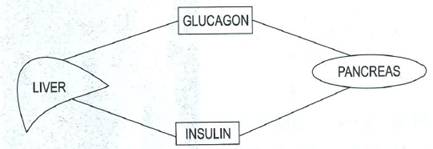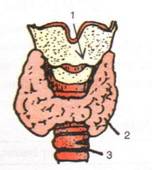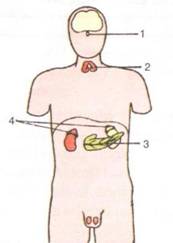Selina Concise Biology Class 10 ICSE Solutions Endocrine Glands
Selina Concise Biology Class 10 ICSE Solutions Endocrine Glands
Exercise 9
A.1.A gland having endocrine as well as exocrine function
(a) Pituitary
(b) Thyroid
(c) Pancreas
(d) adrenal
(a) Pituitary
(b) Thyroid
(c) Pancreas
(d) adrenal
(c) pancreas
A.2.Exophthalmic goiter is caused due to the overactivity of
(a) thymus
(b) thyroid
(c) parathyroid
(d) adrenal cortex
Solution A.2.
(b) thyroid
A.3.
Solution A.3.
(c) alcohol
B.1.Name the following:
(a) The three hormones produced by pancreas
(b) The hormone produced by adrenal medulla
(c) The condition caused by the over secretion of insulin
(d) The hormone secreted by beta cells of the islets of Langerhans
(e) The hormone which increases blood pressure
(f) The hormone causing more urine formation
(g) The hormone which stimulates the entire sympathetic nervous system
Solution B.1.
(a) Insulin, glucagon, somatostatin
(b) Adrenaline
(c) Hypoglycemia
(d) Insulin
(e) Adrenaline
(f) Anti-diuretic hormone (Vasopressin)
(g) Adrenaline
B.2.What would a child suffer from, if there was hypo secretion from his thyroid?
Solution B.2.
If there was hyposecretion of the thyroid gland in a child; the child will suffer from cretinism. The symptoms of cretinism are dwarfism, mental retardation, etc.
B.3.Choose the odd one out from each series:
(a) The glands - thyroid, adrenal, pituitary, prostate
(b) The conditions - cretinism, myxoedema, goiter, scurvy
(c) The hormones- insulin, glucagon, cretinism, thyroxine
(d) The hormonal sources - adrenal cortex, adrenal medulla, cortisone, pituitary
Solution B.3.
(a) Prostate
(b) Scurvy
(c) Cretinism
(d) Cortisone
B.4.Identify the odd one in each of the following and mention what the rest are:
(a) Larynx; glucagon; testosterone; prolactin
(b) Adrenaline; penicillin; insulin; thyroxin
(c) Stomach; ileum; liver; adrenaline
(d) TSH; GH; ADH; insulin
(e) Iodine; cretinism; goiter; myxoedema
Solution B.4.
(a) Larynx
Reason- Larynx is the sound box while the rest three i.e. glucagon; testosterone and prolactin are hormones.
(b) Penicillin
Reason – Penicillin is an antibiotic while adrenaline; insulin; thyroxine are hormones.
(c) Adrenaline
Reason – Adrenaline is a hormone while the stomach, ileum and liver are the organs of the digestive system.
(d) Insulin
Reason- Insulin is secreted by the pancreas while TSH, GH, ADH are the hormones secreted by the pituitary gland.
(e) Iodine
Reason- Iodine is required for the synthesis of thyroxine hormone. While cretinism, goitre, myxoedema are the deficiencies occur due to the deficiency of thyroxine.
B.5.Match the items of column I with those of column II.
Column I
|
Column II
|
1. Beta cells of islets of Langerhans
|
(a) condition due to under secretion of thyroxine in adults
|
2. Thyroid
|
(b) Undersecretion of glucocorticoids
|
3. Cretinism
|
(c) Exophthalmic goitre
|
4. Addison's disease
|
(d) Increases heart beat
|
5. Hypothyroidism
|
(e) Thyroxine
|
6. Myxoedema
|
(f) Adrenal cortex
|
7. Adrenaline
|
(g) Insulin
|
8. Cortisone
|
(h) Under secretion of thyroxine in a child
|
Solution B.5.
B.6.Match the conditions in column A with the cause in column B.
A (Condition)
|
B (Cause)
|
(a) Dwarfism and mental retardation
|
i. Excess of glucose in blood
|
(b) Diabetes mellitus
|
ii. Over secretion of growth hormone
|
(c) Shortage of glucose in blood
|
iii. Insulin shock
|
(d) Gigantism
|
iv. Over secretion of thyroxine
|
(e) Enlargement of breasts in adult males
|
v. Hypothyroidism
|
(f) Exophthalmic goitre
|
vi. Over secretion of cortical hormones
|
Solution B.6.
C.1.Mention which of the statements are true (T) and which are false (F). Give reason in support of your answer.
(a) Adrenaline is often described as the emergency hormone. (T/F)
(b) There are two kinds of diabetes (mild and severe) related with two different hormones. (T/F)
(c) Simple goitre can be prevented by using iodised salt in food. (T/F)
(d) Pituitary is popularly called the master gland. (T/F)
(e) Hormones "obey" the commands like "enough, slow down" or "too little, speed up". (T/F)
(f) Gigantism and dwarfism in humans basically depend on the quality and quantity of the food eaten during early growing age. (T/F)
Solution C.1.
(a) True
Reason- Adrenaline is described as emergency hormone because during any emergency situation more adrenaline is secreted which makes the heart beat faster, increases the breathing, releases more glucose into the blood stream to fulfill the energy requirement.
(b) False
Reason- The two different kinds of diabetes are diabetes insipidus caused due to insufficient secretion of vasopressin and the other is ‘diabetes mellitus’ caused due to hyposecretion of insulin but they cannot be described as mild and severe.
(c) True
Reason-Iodine is an active ingredient in the production of the thyroxine hormone.
(d) True
Reason- Pituitary gland controls the functioning of all the other endocrine glands.
(e) True
Reason- Hormones are poured directly into blood the blood stream and control physiological processes by chemical means. Their action depends on the feedback mechanism.
(f) True
Reason- Gigantism and dwarfism are controlled by the growth hormone from the pituitary gland. Growth hormone is much more active in children for their normal body growth along with which necessary substance required for the synthesis of growth hormone need to be consumed.
C.2.How do endocrine glands differ from other glands?
Solution C.2.
Endocrine glands are ductless glands, means they pour their secretion i.e. hormones directly into the blood stream while the other glands are exocrine glands which have ducts. Through ducts they pour their secretions (not hormones) into the blood stream.
C.3.Mention any two differences between a hormone and an enzyme.
Solution C.3.
Hormones unlike enzymes are secreted by the endocrine glands only. Also the hormones unlike the enzymes are poured directly into the blood. Hormones can be peptides, steroids, amine but all enzymes are proteins.
C.4.Do you agree with the statement- "All hormones are chemical signals"? Yes/No. Justify your answer.
Solution C.4.
Chemically hormones are peptides, amines or steroids. They are involved in regulating the metabolism of the body. They can bring about specific chemical changes during metabolic process. Therefore hormones can be termed as ‘chemical messengers’.
C.5.Why is iodine as a nutrient, important to our body?
Solution C.5.
Iodine is an active ingredient in the production of the thyroxine hormone secreted by the thyroid gland. Thyroxine hormone is a very essential hormone for our body. In case of its abnormal secretions a person may suffer certain sever disorders. Therefore, it is an important nutrient for our body.
C.6.If you stand to make your maiden speech before a large audience, your mouth dries up and heart rate increases. What brings about these changes?
Solution C.6.
Adrenaline is the hormone which prepares the body to meet any emergency situation. Adrenaline makes the heart beat faster. At the same time, it stimulates the constriction of the arterioles of the digestive system reducing the blood supply of the digestive system which makes the mouth dry.
C.7.If one adrenal gland is removed, the other one gets enlarged to some extent. How do you explain this change?
Solution C.7.
If one adrenal gland is removed, the other one gets enlarged. This is to meet the requirement of hormones produced by the body.
C.8.Name the two kinds of diabetes. Mention their symptoms and causes.
Solution C.8.
1. Diabetes mellitus:
Cause – under secretion of Insulin hormone
Symptoms – excretion of great deal of urine with sugar, Person feels thirsty and loss of weight. In severe cases, the person may lose the eye sight.
2. Diabetes insipidus:
Cause – Under secretion of Anti-diuretic hormone
Symptoms – frequent urination resulting in loss of water from body and the person feels thirsty.
C.9.People living in the low Himalayan hilly regions often suffer from goitre. What could be the possible reason for it?
Solution C.9.
The Himalayan soil is deficient in iodine. Thus, the food grown in such soil also becomes iodine deficient. Due to this reason, when Himalayan people consume iodine deficient food, they do not get the proper intake of iodine. Therefore, people living in the low Himalayan hilly regions often suffer from goitre.
C.10.Given below is a table designed to give the names of the glands, the hormones produced, their chief functions, the effects of over secretion and under secretion in respect of thyroid, pituitary and pancreas. Fill up the blanks 1-13.
S.No.
|
Source
Gland cells
|
Hormone produced
|
Chief function
|
Effect of over secretion
|
Effect of under secretion
|
1.
|
(1) --------
|
thyroxine
|
(2) ----
|
(3)----
|
(4)---
|
2.
|
Beta cells of Islets of Langerhans
|
(5) ------
|
Promotes glucose utilization by the body cells
|
(6) ----
|
(7) ------
|
3.
|
(8) --------
|
Growth hormone
|
(9) ----
|
(10) ---
|
Dwarfism
|
4.
|
(11) ------
|
Vasopressin
|
Increases reabsorption of water from kidney tubules
|
(12) -------
|
(13) ------
|
Solution C.10.

C.11.Complete the following table by filling in the blanks numbered 1 to 7.
Gland
|
Hormone secreted
|
Effect on body
|
(1) -----------
|
(2) -------
|
Regulates basal metabolism
|
Pancreas ("beta" cells)
|
(3) -------
|
Controls blood sugar
|
(4) ------------
|
(5) --------
|
Increases heart beat
|
(6) ------------
|
Thyroid stimulating hormone
|
(7) ------------
|
Solution C.11.
C.12.Complete the following table by filling in the blank spaces numbered 1 to 8.
Gland
|
Secretions
|
Effect on body
|
(1)------------
|
oestrogen
|
(2) ---------------
|
Alpha cells of islets of Langerhans
|
(3) -------
|
(4) ---------------
|
(5) ----------
|
(6) -------
|
Protruding eyes
|
(7) ----------
|
(8) -------
|
Gigantism
|
Solution C.12.
D.1.Compare the hormonal response with the nervous response with respect to their speed, transmission and general nature of changes brought about.
Solution D.1.
D.2.Mention three important differences between the action of hormones and that of nerves in the regulatory mechanism of our body.
Solution D.2.
E.1.Study the diagram given below and then answer the questions that follow:

a. Name the cells of the pancreas that produce (1) glucagon (2) insulin.
b. State the main function of (1) glucagon and (2) insulin.
c. Why is the pancreas referred to as an exo-endocrine gland?
d. Why is insulin not given orally but is injected into the body?
e. What is the technical term for the cells of the pancreas that produce endocrine hormones?
f. Where in the body is the pancreas located?
Solution E.1.
a. Glucagon: Alpha cells of the islets of Langerhans
Insulin: Beta cells of the islets of Langerhans
b. Insulin: It maintains the levels of glucose (sugar) in the blood.
Glucagon: It raises the blood glucose levels by stimulating the breakdown of glycogen to glucose in the liver.
c. An endocrine gland is one which does not pour its secretions into a duct, while an exocrine gland is a gland which pours its secretions into a duct. Because the pancreas produces hormones such as insulin, glucagon and somatostatin directly into the blood and not into a duct, it functions as an endocrine gland. Because it secretes the pancreatic juices for digestion via a duct, it functions as an exocrine gland. Hence, the pancreas is an exo-endocrine gland.
d. Insulin is not administered orally because the digestive juices degrade insulin, and thus the insulin is ineffective in the body.
e. Islets of Langerhans
f. The pancreas is located in the abdomen behind the stomach.
E.2.Given below is a portion from the human body showing some important structure in ventral (front) view.

(a) Where is this portion located in the body?
(b) Name the structures numbered 1-3.
(c) State one main function of each of the structures named above.
(d) Is there any duct to carry the secretions from the structure numbered 2? If so, give its name.
Solution E.2.
(a) This portion is located in the neck region above the sternum.
(b) 1- Larynx, 2 – Thyroid gland, 3 – Trachea
(c) Larynx is the voice box containing vocal cords. It helps in producing sound.
Thyroid gland produces thyroxine and calcitonin which are essential hormones.
Trachea is the wind pipe that helps in passing air to and from the respiratory system while breathing.
(d) Structure 2 is the thyroid gland. It is an endocrine gland, so it is ductless and pours its secretions directly into the blood. Hence, there is no duct.
E.3.Given below is an outline diagram of human body showing position of certain organs.

(a) Name the parts numbered 1 to 4.
(b) What is common to all these parts in regard to the nature of their functions?
(c) Name the nutrient element which is essential for the normal working of part 2.
Solution E.3.
(a) 1- Pituitary gland, 2 – thyroid gland, 3 – pancreas, 4 – adrenal glands
(b) All the glands shown in the above diagram are endocrine glands. They secrete essential hormones and pour their secretions directly into the blood.
(c) Iodine is essential for the normal working of thyroxine.
E.4.Given below are two diagrams (one is correct, the other one is somewhat incorrect) showing the transport of a hormone from its source gland/cell to the target organ/cell.
(a) Which one has the error- A or B?
(b) What is the error?

Solution E.4.
(a) A
(b) Hormone secreted by the endocrine gland is shown in the image A to be moving only in one direction i.e. towards the target organ. But actually the hormones poured into the blood stream may have one or more target sites at a time. The arrows shown are carried to all parts by the blood and their effect is produced only in one or more specific parts.






